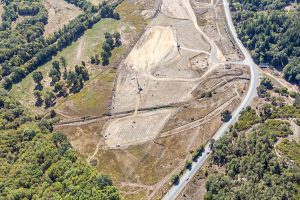Tree Sit Extraction Collage and Tree Sitting Overview
- Written by: savelittlelakevalley
- Category: Uncategorized
- Published: June 13, 2019
On September 18th, over thirty CHP vehicles descended on a clear cut grove of ash trees, where the eighth tree-sit in the Caltrans Bypass bootprint was located, to conduct an extraction. Riot great-clad officers patrolled the tree stumps below the cherry pickers. Two protestors who had been living in the tree locked themselves to a pair of its branches in metal sleeves. The photo gallery at the end of this post is from that day.
The extraction took more than five hours. One of the protesters’ metal lock-boxes was reinforced with concrete, and it took so-called “pain compliance” holds on the part of the CHP SWAT officers to remove him from it.
The now badly-damaged ash grove is 1.5 miles north of Willits, adjacent to Highway 101. It is located in the proposed northern interchange area of the Willits Bypass, where CalTrans’ contractors have been clearing vegetation since April, and have more recently been installing wick drain tubes and dumping soil. The tree sit was on the south edge of the grove, in a valley oak tree that is at least 300 years old. The grove included hundreds of trees and lush under-story plants, which have now been cut down, piled up, and chipped up.
This was the longest tree-sit in the bypass resistance. One of the two protestors who was forcibly extracted on September 18th, who goes by “Condor,” began the tree-sit 137 days earlier, on May 3rd. Since he established the occupation, twelve people in total have spent time living in the tree,affectionately called Polaris by the people who came to know it. Two of these people wrote statements about their motivations for the tree-sit, which you can read here
Tree sits are aerial blockades where someone lives in a platform suspended from a tree to block it from being cut. It is a tactic for defending one’s community and the wilderness. The campaign to change the Caltrans Bypass has been greatly strengthened by tree-sits. Amanda ‘Warbler‘ Senseman scaled a Ponderosa Pine on January 28rd and lived there for 65 days, until forcibly extracted by CHP SWAT on April 2nd at 7 am. This tree sit energized the opposition to the Bypass and helped keep alive the possibility of a far better outcome for the valley, its residents, its wildlife, and future generations.
Following Warbler’s ascent, four more tree sits were established within a mile of her Ponderosa Pine — two in pine trees, and two in oak trees. All four tree-sits were extracted on April 2nd, following Senseman’s extraction. Bean bag ammunition were fired at one protestor in a pine. Another was cut out of a steel lock-box which locked him to an arm of an oak tree.
After April 2nd, two more tree sits were established North of the former tree-sit sites, along side Hael Creek, in an oak and alders. These sites were strategically chosen to prevent Caltrans from engaging in illegal clear cutting of stream-banks.
And on May 3rd, the ash-grove tree sit was established. Click here to see a Caltrans document describing the 1,815 oak trees inventoried to be cut. Obviously, this list doesn’t include pines, madrones, ash trees, manzanitas, dogwood, wild pear trees, shrubs, grasses, or any of the other hundreds of thousands of plants destroyed for the intended construction of this entirely unnecessary freeway.


